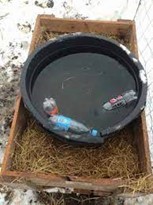Previously published for The Daily Record through OSU Extension Wayne County
I’ve gotten the question a few times – ‘How can I prevent water troughs from freezing without electricity?’ Well, what a very good question indeed. First, let’s talk a little bit of chemistry. Adding salt to water when you’re boiling noodles increases the boiling point of the water, meaning the water is hotter than 212 degrees. This is the same concept with salt water and freezing point; salt water will freeze at a lower temperature than 32 degrees.
 Soda bottle and salt or burying the trough are a couple of solutions
Soda bottle and salt or burying the trough are a couple of solutions
Now that the chemistry is out of the way, it brings us to our first option – making a saltwater float. Using a 2-liter soda bottle, fill it two-thirds of the way with water and add 2 cups of salt, making sure it dissolves. After tightening the cap, place it in your trough. It should float (if it doesn’t, empty a bit of the solution) and break the surface tension of the water without freezing itself. Additionally, if the trough begins to freeze, the stock may learn to press on the bottle to expose fluid water. You also can use a soccer or basketball for the same effect.
Another option is to insulate the trough with a combination of insulation and plywood or burying the trough into the ground. If you’re able, you can build a plywood box around the trough and fill the gaps with Styrofoam, foil-wrapped insulation or spray foam. You can insulate the tank itself with the insulation, but the plywood would act as a windbreak. While the box tactic controls the ‘body’ of the water trough, the surface is still exposed and can freeze. Adding a plywood lid also may work, provided the lid has a couple of access points in which the stock can drink. Putting a hinge on the lid may be a benefit as well, to prevent curious cattle or horses from accidently knocking off the lid and allowing the water to freeze, but also for easy access to scrub the tank if need be.
Burying the trough is similar to insulation in that the ground will be warmer than the air. Dr. Thunes from Clarity Equine Nutrition reports that a drilled 12-inch diameter hole several feet deep directly under the troughs was enough to prevent the water from freezing due to the geothermal heat coming up from the earth.
Location, location, location
Lastly, in the words of our real estate friends, ‘Location, location, location.’ Under a shade tree sounds like a great spot to place a water trough in the summer, but come winter, that same location will hardly ever see sun, especially in the cloudy months of winter. Moving the trough to the sunniest spot in the field during the winter will allow solar radiation to warm the surface of the trough. Therefore, scope out a few different places where you may move water to throughout the year. If all else fails, you may need to break down and heat the trough or come to terms with your trusty hammer. If you end up deciding on a heater, there are several electric options and a couple of propane options, too. The propane options seem to be pricier and meant for large tanks (at least 100 gallons) but are useful if there is no close electric hookup. The electric options range from submersible to floating to tank side to drain plug, depending on what you’re looking for and are usually less than $150.
Keeping water fluid is a tricky thing to do when it’s frigid, but a necessary farm chore of the winter. If you try any of the non-electric options, check the water at least once a day to see how it is working, and always be careful with propane or electric heating elements in barns and around animals.
By: Haley Campbell, Ohio State University Extension, Wayne County, Ohio
![]()


